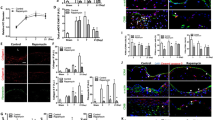Abstract
Percutaneous transluminal angioplasty (PTA) is a very common interventional treatment for treating stenosis in arteriovenous fistula (AVF) used for hemodialysis vascular access. Restenosis occurs after PTA, resulting in vascular lumen loss and a decrease in blood flow. Experimental animal models have been developed to study the pathogenesis of stenosis, but there is no restenosis model after PTA of stenotic AVF in mice. Here, we describe the creation of a murine model of restenosis after angioplasty of a stenosis in an AVF. The murine restenosis model has several advantages, including the rapid development of restenotic lesions in the vessel after angioplasty and the potential to evaluate endovascular and perivascular therapeutics for treating restenosis. The protocol includes a detailed description of the partial nephrectomy procedure to induce chronic kidney disease, the AVF procedure for development of de novo stenosis and the angioplasty treatment associated with progression of restenosis. We monitored the angioplasty-treated vessel for vascular patency and hemodynamic changes for a period of 28 d using ultrasound. Vessels were collected at different time points and processed for histological analysis and immunostaining. This angioplasty model, which can be performed with basic microvascular surgery skills, could be used to identify potential endovascular and perivascular therapies to reduce restenosis after angioplasty procedures.
This is a preview of subscription content, access via your institution
Access options
Subscribe to this journal
We are sorry, but there is no personal subscription option available for your country.
Buy this article
- Purchase on Springer Link
- Instant access to full article PDF
Prices may be subject to local taxes which are calculated during checkout






Similar content being viewed by others
Data availability
The data that support the findings of this study are available from the corresponding author upon request.
References
Al-Jaishi, A. A. et al. Patency rates of the arteriovenous fistula for hemodialysis: a systematic review and meta-analysis. Am. J. Kidney Dis. 63, 464–478 (2014).
Brahmbhatt, A., Remuzzi, A., Franzoni, M. & Misra, S. The molecular mechanisms of hemodialysis vascular access failure. Kidney Int. 89, 303–316 (2016).
Bountouris, I., Kritikou, G., Degermetzoglou, N. & Avgerinos, K. I. A review of percutaneous transluminal angioplasty in hemodialysis fistula. Int. J. Vasc. Med. 2018, 1420136 (2018).
Cai, C. et al. Evaluation of venous stenosis angioplasty in a murine arteriovenous fistula model. J. Vasc. Interv. Radiol. 30, 1512–1521.e3 (2019).
Cai, C. et al. Effect of sex differences in treatment response to angioplasty in a murine arteriovenous fistula model. Am. J. Physiol. Renal Physiol. 318, F565–F575 (2020).
Cai, C. et al. Therapeutic effect of adipose derived mesenchymal stem cell transplantation in reducing restenosis in a murine angioplasty model. J. Am. Soc. Nephrol. 31, 1781–1795 (2020).
Geary, R. L. et al. Time course of cellular proliferation, intimal hyperplasia, and remodeling following angioplasty in monkeys with established atherosclerosis. A nonhuman primate model of restenosis. Arterioscler. Thromb. Vasc. Biol. 16, 34–43 (1996).
Somarathna, M., Isayeva-Waldrop, T., Al-Balas, A., Guo, L. & Lee, T. A novel model of balloon angioplasty injury in rat arteriovenous fistula. J. Vasc. Res. 57, 223–235 (2020).
Yamamoto, K., Li, X., Shu, C., Miyata, T. & Dardik, A. Technical aspects of the mouse aortocaval fistula. J. Vis. Exp. 77, e50449–e50449 (2013).
Yang, B., Shergill, U., Fu, A. A., Knudsen, B. & Misra, S. The mouse arteriovenous fistula model. J. Vasc. Interv. Radiol. 20, 946–950 (2009).
Liang, A., Wang, Y., Han, G., Truong, L. & Cheng, J. Chronic kidney disease accelerates endothelial barrier dysfunction in a mouse model of an arteriovenous fistula. Am. J. Physiol. Renal Physiol. 304, F1413–F1420 (2013).
Castier, Y. et al. Characterization of neointima lesions associated with arteriovenous fistulas in a mouse model. Kidney Int. 70, 315–320 (2006).
Kang, L. et al. A new model of an arteriovenous fistula in chronic kidney disease in the mouse: beneficial effects of upregulated heme oxygenase-1. Am. J. Physiol. Renal Physiol. 310, F466–F476 (2016).
Croatt, A. J. et al. Characterization of a model of an arteriovenous fistula in the rat: the effect of L-NAME. Am. J. Pathol. 176, 2530–2541 (2010).
Manning, E. et al. A new arteriovenous fistula model to study the development of neointimal hyperplasia. J. Vasc. Res. 49, 123–131 (2012).
Lin, T., Horsfield, C. & Robson, M. G. Arteriovenous fistula in the rat tail: a new model of hemodialysis access dysfunction. Kidney Int. 74, 528–531 (2008).
Li, Z. et al. Hyperbaric oxygen inhibits venous neointimal hyperplasia following arteriovenous fistulization. Int. J. Mol. Med. 39, 1299–1306 (2017).
Masaki, T. et al. Inhibition of neointimal hyperplasia in vascular grafts by sustained perivascular delivery of paclitaxel. Kidney Int. 66, 2061–2069 (2004).
Florescu, M. C. et al. Sheep model of hemodialysis arteriovenous fistula using superficial veins. Semin. Dial. 28, 687–691 (2015).
Loveland-Jones, C. E. et al. A new model of arteriovenous fistula to study hemodialysis access complications. J. Vasc. Access 15, 351–357 (2014).
Kraiss, L. W. et al. Acute reductions in blood flow and shear stress induce platelet-derived growth factor-A expression in baboon prosthetic grafts. Circ. Res. 79, 45–53 (1996).
Lafont, A. & Faxon, D. Why do animal models of post-angioplasty restenosis sometimes poorly predict the outcome of clinical trials? Cardiovasc. Res. 39, 50–59 (1998).
Le Bras, A. A resource for selecting animal models of heart disease. Lab Anim. 48, 332 (2019).
Hartung, T. Rebooting the generally recognized as safe (GRAS) approach for food additive safety in the US. ALTEX 35, 3–25 (2018).
Cai, C. et al. Differences in transforming growth factor-β1/BMP7 signaling and venous fibrosis contribute to female sex differences in arteriovenous fistulas. J. Am. Heart Assoc. 9, e017420 (2020).
Gibbons, G. H. & Dzau, V. J. The emerging concept of vascular remodeling. N. Engl. J. Med. 330, 1431–1438 (1994).
Abedin, M., Tintut, Y. & Demer, L. L. Mesenchymal stem cells and the artery wall. Circ. Res. 95, 671–676 (2004).
Ross, R. Atherosclerosis—an inflammatory disease. N. Engl. J. Med. 340, 115–126 (1999).
Jukema, J. W., Verschuren, J. J. W., Ahmed, T. A. N. & Quax, P. H. A. Restenosis after PCI. Part 1: pathophysiology and risk factors. Nat. Rev. Cardiol. 9, 53–62 (2012).
De Marchi, S. et al. Risk factors for vascular disease and arteriovenous fistula dysfunction in hemodialysis patients. J. Am. Soc. Nephrol. 7, 1169–1177 (1996).
Bertheau, P. et al. Variability of immunohistochemical reactivity on stored paraffin slides. J. Clin. Pathol. 51, 370–374 (1998).
Ungvari, Z., Tarantini, S., Donato, A. J., Galvan, V. & Csiszar, A. Mechanisms of vascular aging. Circ. Res. 123, 849–867 (2018).
Caixeta, A. M. et al. [Analysis of elastic retraction in the 1st 15 minutes after coronary balloon angioplasty]. Arq. Bras. Cardiol. 66, 5–9 (1996).
Meurice, T. et al. Role of endothelial cells in restenosis after coronary angioplasty. Fundam. Clin. Pharmacol. 10, 234–242 (1996).
Hanke, H., Strohschneider, T., Oberhoff, M., Betz, E. & Karsch, K. R. Time course of smooth muscle cell proliferation in the intima and media of arteries following experimental angioplasty. Circ. Res. 67, 651–659 (1990).
Staab, M. E. et al. Arterial remodeling after experimental percutaneous injury is highly dependent on adventitial injury and histopathology. Int. J. Cardiol. 58, 31–40 (1997).
Acknowledgements
The authors acknowledge the assistance of Lucy Bahn, PhD for editing the manuscript. This research was supported by NIH grants to S.M. (HL098967 and DK107870).
Author information
Authors and Affiliations
Contributions
C.C. contributed to study design, animal surgeries, data collection, interpretation of data, and manuscript preparation. C.Z. contributed to study design, data analysis, and manuscript preparation. S.K. contributed to study design, interpretation of data, and manuscript review. A.S., A.K.S., M.L.S., A.M., and Y.L. contributed to interpretation of data, and manuscript review. S.M. contributed as a guarantor and to study design, interpretation of data and manuscript editing.
Corresponding author
Ethics declarations
Competing interests
The authors declare no competing interests.
Supplementary information
Supplementary Information
Supplementary Figs. 1 and 2 and legends for Supplementary Videos 1 and 2.
Supplementary Video 1
Technique for AVF creation by anastomosing the end of the right external jugular vein to the side of the left common carotid artery in a mouse. All animal experiments were approved by the Institutional Animal Care and Use Committee of Mayo Clinic.
Supplementary Video 2
Technique for the angioplasty procedure in a stenotic arterialized external jugular vein by using a 1.25 mm × 6 mm coronary artery balloon catheter in a mouse. All animal experiments were approved by the Institutional Animal Care and Use Committee of Mayo Clinic.
Rights and permissions
About this article
Cite this article
Cai, C., Zhao, C., Kilari, S. et al. Experimental murine arteriovenous fistula model to study restenosis after transluminal angioplasty. Lab Anim 49, 320–334 (2020). https://doi.org/10.1038/s41684-020-00659-x
Received:
Accepted:
Published:
Issue Date:
DOI: https://doi.org/10.1038/s41684-020-00659-x



